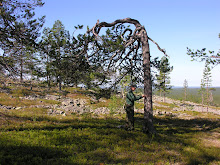Most Finns want to travel to hot and sunny regions whenever possible, but I like cool places even more. So when the opportunity to participate SNS forest inventory seminar in Egilsstaðir, East Iceland, emerged in last winter, there was no reason to hesitate. Even though our Joensuu university delegation’s pre-journey feelings suggested that this trip should probably be classified as “scientific tourism”, the official part of the programme included many interesting presentations about NFI and laser scanning topics. Also the country reports gave a clear view of the related research in the Nordic and Baltic countries. Highlight of my own presentation was the international revelation of the crown relascope, a new instrument for canopy cover measurements. Still, when the last “never-ending” session was finally finished, everyone was quite happy to get out of the auditorium to really see Iceland.
An old Icelandic joke reveals an answer to the question ”What do you do if you get lost in an Icelandic forest? Just stand up”. It soon became clear that the modern Icelandic foresters don’t much like this joke. After visiting several forests near Egilsstaðir and Akureyri it became clear that they have a good reason to be proud of their success in increasing forest cover in a rather hostile environment. When the first tree in the country reached 20 meters height, the prime minister solemnly placed a memorial plate on the site of the historical event. Although we heard that some Icelanders are afraid that afforestation will destroy their open sceneries and make the country “look like Finland”, they are still very attracted to camping in forests by the lakes and rivers. Controversial?
 Finnish larch going strong in the middle of the North-Atlantic
Finnish larch going strong in the middle of the North-Atlantic

Not to be afforested in the near future
An old Icelandic joke reveals an answer to the question ”What do you do if you get lost in an Icelandic forest? Just stand up”. It soon became clear that the modern Icelandic foresters don’t much like this joke. After visiting several forests near Egilsstaðir and Akureyri it became clear that they have a good reason to be proud of their success in increasing forest cover in a rather hostile environment. When the first tree in the country reached 20 meters height, the prime minister solemnly placed a memorial plate on the site of the historical event. Although we heard that some Icelanders are afraid that afforestation will destroy their open sceneries and make the country “look like Finland”, they are still very attracted to camping in forests by the lakes and rivers. Controversial?
 Finnish larch going strong in the middle of the North-Atlantic
Finnish larch going strong in the middle of the North-Atlantic
Not to be afforested in the near future

